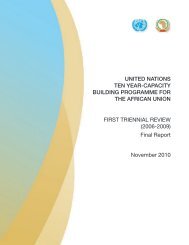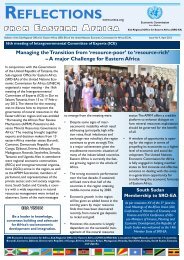Tool kit for Gender and Agriculture - Economic Commission for Africa
Tool kit for Gender and Agriculture - Economic Commission for Africa
Tool kit for Gender and Agriculture - Economic Commission for Africa
Create successful ePaper yourself
Turn your PDF publications into a flip-book with our unique Google optimized e-Paper software.
12<br />
<strong>Gender</strong> in <strong>Agriculture</strong><br />
Table 1: Returns to Increasing the Human <strong>and</strong> Physical Capital of Women Farmers<br />
Maize farmers, Kenya,<br />
1976<br />
Food crop farmers, Kenya,<br />
1990<br />
When women farmers<br />
have the following:<br />
The age, education, <strong>and</strong><br />
input levels of men farmers<br />
Primary schooling<br />
The age, education, <strong>and</strong><br />
input levels of men farmers<br />
The same l<strong>and</strong> area as men<br />
farmers<br />
The fertilizer level used by<br />
men farmers<br />
Source: Moock 1976; Saito, Mekonnen, <strong>and</strong> Spurling 1992.<br />
Table 2: Positive Results When Attention Is Paid to <strong>Gender</strong> Equity<br />
Yield increases by this<br />
percent:<br />
9.0<br />
When: Positive Results Are:<br />
Women have better access • They often have a greater increase in productivity<br />
to <strong>and</strong> control over re-<br />
than men.<br />
sources.<br />
• They employ credit more efficiently than men <strong>and</strong><br />
have excellent repayment rates.<br />
Women have more free<br />
time.<br />
• They invest more than men in productive activities.<br />
Women have better access • Production increases.<br />
to <strong>and</strong> control over their in- • Birth rate decreases as fast as their income income.creases.<br />
• Children’s education increases.<br />
D. <strong>Gender</strong> Analysis in Project Design<br />
Evidence from many countries shows that women usually do not benefit automatically<br />
from agricultural development projects. <strong>Gender</strong>-neutral programs can sometimes bypass<br />
or be detrimental to women. <strong>Gender</strong> analysis as defined below will, there<strong>for</strong>e,<br />
more often need to focus on women than on men. Special steps to include women <strong>and</strong><br />
overcome constraints to their participation are usually needed.<br />
<strong>Gender</strong> analysis can significantly increase efficiency, sustainability, <strong>and</strong> equity<br />
in interventions <strong>for</strong> rural <strong>and</strong> agricultural development. The aims of using gender<br />
analysis in agriculture are to:<br />
24.0<br />
22.0<br />
10.5<br />
1.6







